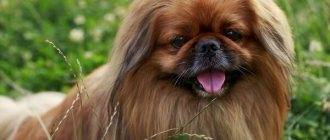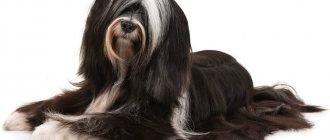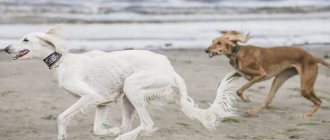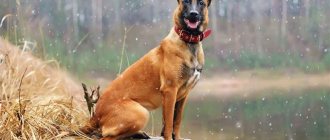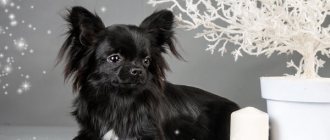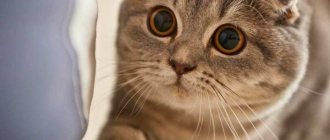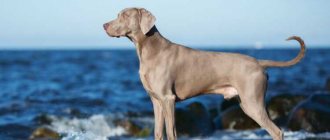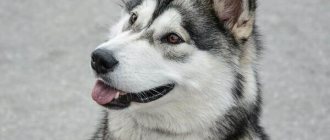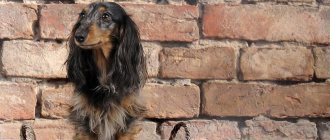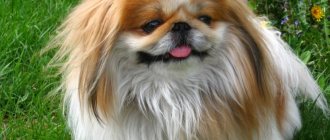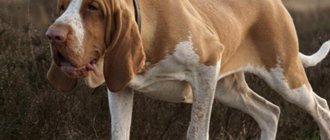Pekingese - the dog of Chinese monarchs, the history of the breed, the origin of which is shrouded in legends. Historians find first mention of dogs, similar to domestic dwarf lions, dating back to 4 thousand years ago.
But it is, unfortunately, impossible to trace the origin of the breed with documentation, exactly when people decided to breed Pekingese. The breed is named “Pekingese” in honor of Beijing, where it comes from, and therefore the correct name for the dog breed is not “Pekingese”, but Pekingese.
In China, only the rich could keep these babies at home; ordinary people did not breed them under pain of the death penalty.
But history does not stand still, and in the 18th century the British, who captured the capital of China, took a liking to the appearance of the breed, deciding that these dogs should be bred in Europe .
Since the 19th century, Pekingese began to be bred in America , and at the beginning of the 20th century, the first clubs of this breed were opened and official standards were introduced.
History of the breed
The Pekingese's homeland is China, where it was bred specifically for the imperial family. The dogs lived at court and were decorations of the imperial chambers. If the owner died, the dog was buried with him, and for stealing a Pekingese, the criminal faced the death penalty. The roots of the breed go back to Central Asian wolves; close and distant relatives of the Pekingese are pugs, Shih Tzus, Papillons and Chihuahuas.
There is an amazing legend about how this breed appeared. The Chinese have shrouded the history of their beloved dog breed in mysticism and magic. One day a big and strong lion fell in love with a little monkey - anything can happen in this world. But they couldn’t be together: he’s so big and she’s so small. A kind magician came to their aid; at the request of the unhappy lovers, he reduced the lion in size. The lion and the monkey lived happily, and soon they had children - Pekingese dogs. This is how the Chinese people unusually designated the emergence of a new breed - the Pekingese, their pride.
Vaccination
Modern complex vaccines for dogs protect the animal from the most common and dangerous infections, including rabies, plague, rhinotracheitis, coronavirus infection, parvovirus enteritis, leptospirosis, and adenoviral hepatitis. In Russia, the following drugs are more often used: Eurican, Nobivak, Vanguard-7, Hexadog, Vanguard-5, Duramun. The dog tolerates them well and without complications.
The Pekingese is vaccinated according to the following scheme:
- from 6 to 8 weeks - first vaccination;
- at 10 weeks - revaccination;
- after changing teeth - the third vaccination.
Further, annual vaccination is provided. Every six months, Pekingese are dewormed and their fur is regularly treated for parasites. After these procedures, vaccination can be given no earlier than a week later. Only healthy animals are allowed to be vaccinated.
Interesting facts about Pekingese
– In Ancient China, each Pekingese had its own servant who looked after the dog. The puppies were not fed by their mother at all; they were hand-fed with human milk.
– Dogs first came to Europe at the end of the 19th century; in 1894, the Pekingese was shown at an exhibition in England. After 7 years, the breed became known throughout Europe; they began to be bred in nurseries in Germany, the Netherlands and other countries.
– Today it is very difficult to find a purebred, purebred Pekingese. Experts say that many dogs called Pekingese only vaguely resemble this breed. In Ancient China, the breed was cultivated according to certain criteria; there are records that say how the curves of the body, tail, and head are in harmony with imperial furniture, gold utensils and room decoration.
How to choose a puppy
Pekingese are a fairly popular breed, so even nurseries can be unofficial, but in order to get a high-quality healthy puppy, you need to contact only trusted services.
Healthy puppies will be playful, active and clean . They should not have obvious pathologies or deviations from the standard. The price depends on the status of the pet; a dog without a pedigree will cost 8,000 rubles , and a show-class pet suitable for exhibitions will cost 30,000 rubles.
The Pekingese is a great option for older people or single busy people. They do not need active walking or specialized training. One way or another, any dog needs care and attention, so before buying a puppy you need to make sure you are willing and able to spend time on your pet.
5 / 5 ( 1 voice )
Purpose and character of the Pekingese
The Pekingese will make an excellent friend and companion; these dogs become very attached to their owner. True, then you may encounter such a phenomenon as jealousy; Pekingese do not like to share “their person” with anyone else. This breed is suitable for everyone, but small children should be careful with a puppy, and even an adult dog, so as not to injure it. By nature, Pekingese are quite calm, not aggressive, but fearless; the pet must be protected from danger. They are proud, selfish, wayward. Pekingese are smart and well-mannered, but you should not rely only on character and neglect training, otherwise you will become a servant of the imperial dog.
Pekingese are not only jealous, but also touchy; they can be hurt by inattention, lack of affection, or the manifestation of feelings towards another animal or person. We will have to try to return him to his former cheerful mood. Dogs are aristocratic, this is both a plus and a minus of the breed. On the one hand - refined manners, dignified behavior, on the other - pickiness and capriciousness. Be prepared for the fact that dogs of this breed snore quite loudly and sneeze often, this is due to brachycephaly - a short muzzle.
1 of 11
Health
With proper care and proper diet, the Pekingese will delight its owners with a healthy, beautiful appearance for up to 13-15 years. The owner of such a pet should know what diseases representatives of this breed are predisposed to:
- Eye diseases - ectropion, corneal ulcers, retinal atrophy.
- Cardiovascular diseases.
- Urolithiasis is an intractable and dangerous disease. It often manifests itself as blatant uncleanliness.
- Patella dislocation - accompanied by lameness.
- Intervertebral disc disease - leads to severe pain and neurological disorders.
- Cleft palate - a gap in the middle part of the palate that occurs as a result of non-fusion of the two halves of the palate during embryonic development
- Brachycephalic syndrome is associated with shortening and deformation of the skull, as well as excess soft tissue of the head. With this syndrome, respiratory failure is noted.
- Ectopic pregnancy.
- Keratoconjunctivitis sicca is a severe eye pathology that can lead to blindness.
- Hydrocephalus is a congenital disease characterized by excessive formation of cerebrospinal fluid in the cerebral ventricles.
- Cryptorchidism is not testicular descent in a male dog.
- Skin diseases.
When buying a puppy, pay attention to the entire litter. If there are sick individuals among the puppies, it is better to refuse the purchase and find another breeder. Once you have decided on a dog, examine it so as not to bring home a sick animal. A healthy puppy has a clean coat, free breathing, and shiny eyes. There should be no discharge from the nose or eyes. The dog must be active and keep its tail raised.
It is easier to prevent a disease than to treat it later. Therefore, it is recommended that your dog undergo a preventive examination at a veterinary clinic once a year. It is also important to do routine vaccinations on time and treat your dog with medications against skin parasites and worms.
Breed standard
Pekingese are world famous and loved. There are several different breed standards (English, Russian and American), but there are no significant differences in the evaluation criteria. The differences mainly relate to the weight and size of the dog.
Male parameters: height: 16-24 cm, weight: 4-7 kg; females height: 14-22 cm, weight: 4-5 kg. Sometimes you can find smaller Pekingese whose weight is less than three kilograms. This is not a separate breed or a dwarf variety of Pekingese, these dogs can be born in any litter. The coat is dense, long, straight, the color can be any color, plain and with markings, except chocolate and pure white (albino).
Dogs of this breed are small in size and have a dense, muscular build. The back is long, the withers are clearly defined. Their paws are large and strong, oval, flat, with markings on the front ones. The Pekingese should not squat on its pasterns; a purebred dog stands firmly on its paws. The dog's head is massive and seems even larger due to the mane covering it and its neck. The neck is short, without skin folds. The forehead is wide, flat, the muzzle is wide, short and upturned, the nose is black, flattened, the nostrils are raised, there is a transverse fold on the bridge of the nose. The transition from the muzzle to the forehead is sharp, the lower jaw is powerful. The ears are small, drooping, and heart-shaped. The tail is set high and heavily covered with hair.
Theses
- Due to the structure of the skull, Pekingese dogs make different sounds and sometimes snore.
- Due to the structure of the eyes, they are prone to injury and can... fall out. In fact, this is a dislocation, but it terrifies owners and can have consequences if not contacted by a veterinarian in time.
- These small dogs have a complex character, one of the manifestations of which is independence.
- They get along with children, but only with those who respect them.
- They are difficult to toilet train.
- They usually love one person more.
- They tolerate heat extremely poorly due to their thick coat and skull structure.
- They get along well with dogs and other pets.
Pekingese care
The Pekingese is great for indoor living; it is not a breed that needs long walks or exercise. The dog will be happy to walk with you to the store, sit on a bench in the park, or walk sedately along the alley. Pekingese can run and frolic, but they do it for pleasure and according to their mood, and not on every walk. The Pekingese coat consists of two types of hair: long and coarse, and short and fine - undercoat. These dogs should be combed and combed as often as possible; this, firstly, makes them beautiful, and secondly, prevents their fur from rolling into tangles. On the paws, around the pads, the hair is trimmed, the claws are trimmed, and the folds on the bridge of the nose are wiped. Periodically, the dog is bathed with shampoo. The diet should be complete and balanced; Pekingese are very picky, so it is important to choose the type of food that the dog will eat with pleasure and at the same time receive all the necessary nutrients. Pekingese are characterized by some diseases, such as ectropion or cataracts, respiratory diseases, problems with the spine and musculoskeletal system, and heart failure. For breeding, it is preferable to take young females, even from their first heat. An older dog may die in childbirth if it is not given a caesarean section.
Dog diet
Your pet needs a balanced and high-quality diet - natural food or dry food.
List of permitted products:
- Lean meat, boiled. Preferably veal or turkey, beef is too tough, chicken is an allergenic product.
- Occasionally they give rice and oatmeal; excessive consumption of carbohydrates will lead to weight problems.
- Vegetables, excluding potatoes and corn.
- Dairy products: low-fat cottage cheese and kefir, natural yogurt, homemade cheese are the favorite delicacies of the Pekingese breed, whose origins began with imperial dogs. They ate gourmet meals prepared by a personal chef. Current representatives of the breed have to be content with ordinary food.
- Once a week, a boiled quail egg is allowed.
- The menu must include a vitamin complex and fish oil.
Feeding natural food does not provide the animal with the vitamins that “drying” provides. Choose super-premium food for small breed dogs.
Application
Nowadays, the Pekingese dog is acquired mainly as a family friend and an active participant in various exhibitions.
Such a pet, like the Pomeranian Spitz and Petit Brabançon , will relieve stress and charge you with its energy, which is especially valuable for residents of noisy cities.
The animal loves short but frequent walks, it is easy to be handled, and loves to be petted and praised.
This is an ideal pet for home and apartment. trained at home .
Other breeds suitable for keeping in an apartment are described in the article
Estrus, mating, birth
The Pekingese's first heat occurs at eight months of age, lasts approximately 14 days and repeats every six months. The ideal age for mating is from 1.5 to 2 years, but not older than 3 years. Late first mating can cause many complications, including false puppies; if the situation is repeated many times, the bitch is sterilized.
It is better to agree with the owner of the male dog in advance and choose a backup option so as not to miss days favorable for conception. It is not recommended to feed or bathe the bitch before mating. Dogs must be introduced carefully so that they do not injure each other. Pekingese are usually bred on a table, with the owner holding the bitch. The condition of both animals must be monitored; the crossing process takes a lot of energy, and the Pekingese may lose consciousness. After a couple of days, the procedure should be repeated to consolidate the result. Proper mating of Pekingese is the key to the birth of healthy offspring. After 20 days, the bitch needs to have an ultrasound to make sure that pregnancy has occurred and to provide the dog with proper care.
Pregnancy in the Pekingese lasts on average 63 days. If the litter is large, the puppies are born a little earlier; if the litter is small, the puppies are born a little later. Viable healthy offspring are born from 53 to 71 days after mating. You need to prepare for the birth itself and agree with the veterinarian so that he can quickly come to the rescue if problems arise.
Signs of approaching labor are:
- drop in body temperature to 37 degrees (about two days before birth);
- prolapse and thickening of the abdomen;
- thick discharge from the loop.
After this, the waters recede. You cannot leave the bitch alone at this moment. Immediately after birth, puppies should not be brought to the dog’s face; in firstborns, the maternal instinct usually does not awaken immediately, and the pet may behave unpredictably. During the postpartum period, it is necessary to give the bitch as much attention as possible so that she does not become jealous of the owner for the puppies. Pekingese can perceive cubs as competitors, so a person needs to show maximum love and attention.
